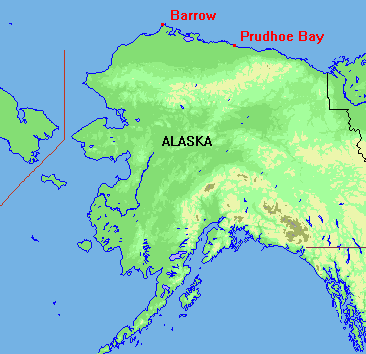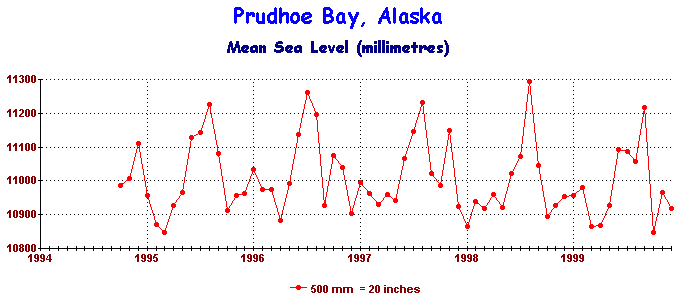|
A Clap
of Thunder John L. Daly
Introduction On 19th June 2000, a rare event occurred at Barrow, Alaska, which was to snowball its way into the scare politics of global warming, an event told, retold, and finally exaggerated out of all proportion. An hour before midnight on the 19th June 2000, Barrow experienced a thunderstorm.
The Day of the Thunderstorm When the thunderstorm occurred, it was mid-summer just two days before the summer solstice, with the Artic daylight lasting the full 24 hours of each day. The sea was by then clear of pack ice providing the atmospheric moisture necessary to feed a thunderstorm. The next day, the National Weather Service announced the thunderstorm event as quoted below
Notice that the two previous thunderstorms since 1978 also occurred in mid summer. The bulletin described the thunderstorm as `rare', but clearly not unprecedented. However, this is not the way it remained. The Anchorage Daily News reported the thunderstorm repeating the fact that this was the third such event in 22 years. They also revealed that the Inupiat people had a word for it - "kalluk", meaning "thunderstorm" or "to thunder". (The mere existence of such a word in the Inupiat language implies that the occurrence, though rare, does nevertheless happen from time to time in their history.) That is not the way the rest of the country heard it. Within days, the `rare' event had become `the first ever thunderstorm at Barrow', a sure sign that the horrors of `Global Warming' was upon us. This new spin on the story was not simply restricted to the environmental media, but was also reported that way in the mainstream media, in the Australian press, and also - incredibly - by the World Meteorological Organisation (WMO), and even the NOAA itself. A single weather event, of little importance in itself, had become the dramatic `smoking gun' of global warming, referred to repeatedly in both media and scientific circles in the run-up to the Hague Conference. As yet another `global warming' story, it was soon eclipsed by other similar scare stories, all softening up the public prior to the upcoming Hague Conference designed to stampede countries into signing and ratifying the Kyoto Protocol. As we now know, the Hague Conference failed to reach agreement due to the European refusal to consider `sinks' (such as forests to soak up surplus carbon dioxide), and the election of President Bush signalled an end to the stalled Kyoto process, resulting finally in his statement this year that the U.S. would not sign the protocol. Enter the Senator Since Bush's announcement, the U.S. Senate Commerce Committee has been conducting hearings into climate change and the state of the science underpinning the global warming theory. Several expert witnesses appeared including James Hansen and Richard S. Lindzen. But most surprising was the statements by Alaska senator Ted Stevens, as reported in the Nando Times. Here is an edited version of the story, focusing on Steven's comments in relation to Barrow.
Again we find the false `first-ever thunderstorm' claim being repeated, this time by one of Alaska's own senators. But now he adds yet a further twist to an already over-hyped story, the rising sea levels forcing the relocation of Barrow itself. Is there any substance to this claim? As it happens there is a tide gauge operating 200 miles away at Prudhoe Bay on the same stretch of coast, its data registered with the Permanent Service for Mean Sea Level. The data for Prudhoe Bay is shown below, scaled in millimetres (25 mm equals 1 inch) -
As can be readily seen, this coastline is subject to surges in sea level during the summer months, followed by a fall in level during the winter. The graph itself is scaled between 10,800 mm and 11,300 mm, a range of 500 mm or 20 inches. The sea level varies by nearly that amount between summer and winter, posing erosion problems for such a low lying marshy coastline. 1998, the year of the big El Niño, caused a short-lived rise in sea level globally, and this shows up also at Prudhoe Bay with an one-off August peak in 1998. Apart from that, there is little in the above record to suggest anything but a stable sea level with a 17-inch variability through the year. While Barrow is clearly vulnerable to coastal erosion given its low height above sea level and the eroding lagoons all around it, that erosion has nothing to do with rising sea level, but simply a natural geological process at work. It has been happening on many other coasts for centuries. As for re-locating Barrow, that too is untrue. The only Inuit villages which are being considered for relocation are the villages of Shishmaref and one or two others on the north coast of the Seward Peninsula. The reason for their possible relocation is beach erosion, not sea level rise. Barrow is not being considered for relocation, contrary to what the senator claimed. Arctic Thunderstorms Finally, we could ask to what extent thunderstorms occur in the Arctic. Are they unprecedented as the Barrow Thunderstorm scare stories suggested, or do they happen at regular, if infrequent, intervals? According to www.junkscience.com, Captain Franklin once said in his journal - "... They reached the mouth of the Mackenzie on 30 August in a violent gale with thunder, lightning and torrents of rain." This was in 1826 and the mouth of the Mackenzie River is at about the same latitude, roughly 20° longitude east of Barrow. An article titled `Arctic Thunderstorms' by T. Neil Davis, (a seismologist at the Geophysical Institute, University of Alaska Fairbanks), for the Alaska Science Forum, dated August 11, 1979, tells us more about these events historically. According to Davis -
Since these words were written in 1979, we have had three such thunderstorms at Barrow. Given the sparseness of population over such a vast wilderness, other thunderstorms which may have passed over unpopulated regions would have gone completely unreported. But they do happen, they have always been happening, and they will happen again. We certainly do not need to blame `global warming' for them. The Barrow saga also demonstrates that the public cannot accept on trust the alarmist claims and misrepresentation of weather events by environmental groups, or the media. Even many of the scientific institutions have failed in their duty of care to properly inform the public and to keep periodic events like the Barrow thunderstorm in their proper perspective. |


